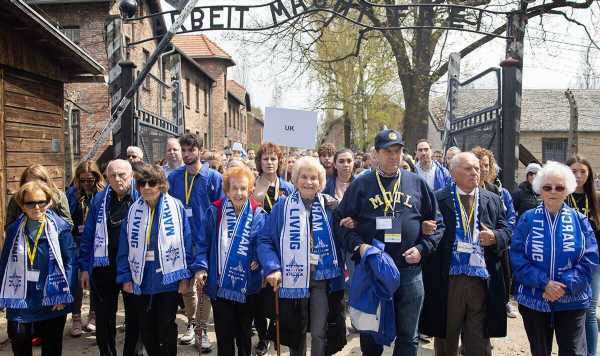Joanna Lumley meets Holocaust survivor in Berlin
We use your sign-up to provide content in ways you’ve consented to and to improve our understanding of you. This may include adverts from us and 3rd parties based on our understanding. You can unsubscribe at any time. More info
What is identity? Why does it matter? What’s specific to identity and what’s universal? I and the thousands of other attendees at this years March of the Living – an annual event in Poland that serves to educate about the Holocaust – were asked these searching questions.
You might be wondering why the event encourages its participants to ponder such big questions. After all, doesn’t the horror of the Holocaust speak for itself? Do you not risk abstracting away its impact?
After engaging in a vigorous discussion with the other participants on the first day, I quickly understood the utility of this approach: to guard against absolutism and binary ways of thinking.
By deconstructing the concept of identity, it steers people away from dogma and othering, both of which facilitated the systematic state-sponsored killing of six million Jewish men, women, and children and millions of others by Nazi Germany and its collaborators during World War II.
This sharpened my tools of inquiry as I embarked on the five day event, which initially sweeps across 1000 years of Jewish history in Poland.

The POLIN Museum of the History of Polish Jews in Warsaw provided the perfect springboard. Starting with the arrival of Jews in the 10th century, our animated tour guide took us through a millennia marked by alternating periods of persecution and peace.
The museum itself is filled with intriguing artefacts collected throughout history and creative set pieces which bring Jewish history to life.
It’s worth setting aside the best part of a day to really take in all that the museum has to offer.
The March of the Living itinerary was well thought out. By showing you the rich, cultural patchwork of Jewish life throughout the centuries, you develop a heightened sense of what was lost in the Holocaust.
DON’T MISS
Florence: A luxurious 48 hours in Tuscany’s capital [INSIGHT]
Holy sites for an Easter pilgrimage: Lourdes, Jerusalem and Rome [TRAVEL]
Stressed Brits need a trip away every 46 days – popular destinations [TIPS]
Still, I was not prepared for what came next.
What makes March of the Living so unique is that accompanying you on the trip are a group of Holocaust survivors, each of whom come with their own painful yet inspiring story.
To walk side by side with these larger than life figures as they recounted their experiences and relived their traumas was unforgettably moving.
I will never forget the moment Holocaust survivor Mala Tribich led us to the edge of Rakow forest, which is near her hometown of Piotrków Trybunalski. Mala lit a candle next to a stone plaque. Against the stillness of the trees, she revealed that we were standing next to the site where her mother and sister along with hundreds of others were brutally murdered in newly dug mass graves.
“It’s a tragedy you never get over,” she said.

Sombre reflections such as this defined the next part of the trip. Over two days, I listened to the testimonials of several survivors and was guided around Auschwitz – a network of concentration camps where at least 1.1 million prisoners died.
Walking around the camps, death and destruction pervaded the air. As our tour guide reeled off the litany of offences, it was hard to feel anything other than despair.
Yet another feeling took me by surprise: hope. March of the Living is a paean to the strength of the human condition.
Listening to Mala and the other survivors speak, it was clear that they are not defined by the Holocaust. Far from it. Their voices firm not faltering. Each spoke with courage, heart and humanity.
What’s more, the survivors have all gone on to forge hugely successful and meaningful lives.
I was struck by the resilience of the human spirit.
The event also taught me a lot about friendship. I became very close with the other attendees, many of whom had familial connections to the Holocaust.

When one of us became overwhelmed, another was on hand to offer a shoulder to cry on or a keen ear.
At the end of each day, we also took part in a “reflections” session. This was a way of decompressing the events of the day and sharing our experiences. It also served to strengthen our bonds and make the trip all the more special.
The event culminated in the “March of the Living” – a 3km walk from the gates of Auschwitz concentration camp to the gas chambers where millions were mercilessly killed.
Returning to the camp, the mood was markedly different. This was a celebration of the indomitable spirit of the Jewish people. It felt defiant.
Stirring speeches from prominent figures in the Jewish community and other backgrounds closed the event.
Echoes of Ukraine rumbled throughout, with rallying calls to hold the line against tyranny.
March of the Living brought me closer to understanding the best and worst aspects of humanity.
While questions remain unanswered, I now have a clearer understanding of the world I want to live in and my place in that world.
This insight alone makes March of the Living an essential trip.
Source: Read Full Article
